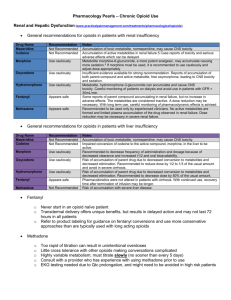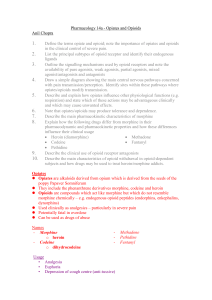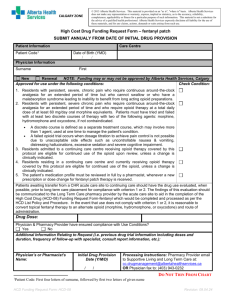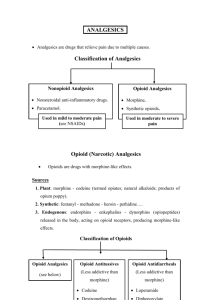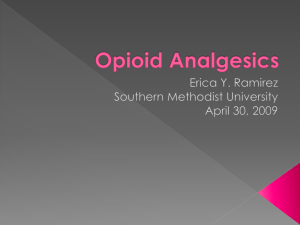Opioids
advertisement
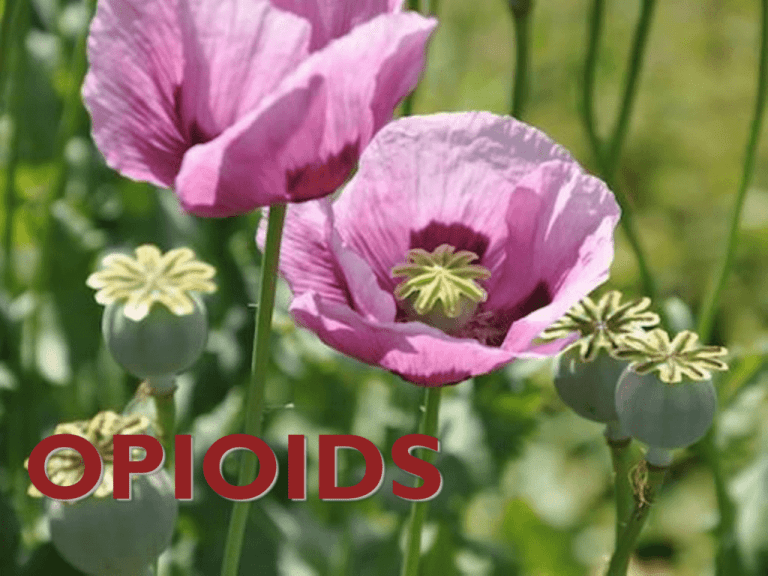
OPIOIDS DEFINITIONS Opium : a mixture of alkaloids from the poppy plant - papaver somniferum Opioid : any naturally occurring, semi-synthetic or synthetic compounds that bind specifically to opioid receptors and share the properties of one or more of the naturally occurring endogenous opioids Opiate : any naturally occurring opioid derived from opium Narcotic : Greek word meaning to numb or deaden. denote an opioid but also widely used to describe drugs of addiction and hence includes non opioid compounds MECHANISM OF ACTION Activate opioid receptors. Opioid receptors are distributed throughout the CNS with high concentrations in the nuclei of tractus solitarus, peri-aqueductal, cerebral cortex, thalamus & substantia gelatinosa of the spinal cord. MECHANISM OF ACTION Opioid receptors are coupled with inhibitory G-proteins & their activation has a number of actions: - closing of voltage sensitive calcium channels, - stimulation of potassium efflux leading to hyperpolarization & reduced cyclic adenosine monophosphate (cAMP) production. Overall, the effect is a reduction in neuronal cell excitability reduced transmission of nociceptive impulses. Agonist Pure opioid agonists bind to opioid receptors avidly & demonstrate high intrinsic activity at the cellular level. Eg : Morphine Partial Agonist Partial opioid agonists (buprenorphine) bind to opioid receptors but produce a sub-maximal effect compared to pure agonists. Antagonist have receptor affinity but no intrinsic activity. Eg : Naloxone MCQ Drugs which could potentially prevent an abstinence withdrawal syndrome during hospitalization include: A. morphine B. nalbuphine C. methadone D. butorphanol E . Hydromorphone OPIOID RECEPTORS Since their identification, opioid receptors have had a variety of names. Current nomenclature approved by International Union of Pharmacology : ◦ ◦ ◦ ◦ MOP (mu opioid peptide receptor ) KOP (kappa opioid peptide receptor) DOP (delta opioid peptide receptor) NOP (nociceptin orphanin FQ peptide receptor) The sigma receptor is no longer classified as an opioid receptor. A number of different subtypes of each receptor exist; 2 MOPs, 3 KOPs & 2 DOPs. Endogenous opioids Produced in the body and widely distributed throughout the CNS. They have numerous actions including modulation of pain & control of the CVS system, particularly in shock. Endogenous opioids currently have no clinical role. Opioids with their selectivity for different opioid receptors RECEPTOR TYPE Opioid MOP KOP DOP NOP +++ +++ +++ - Leu-enkaphin + - +++ - Dynorphin A & B ++ +++ + + - - - +++ Morphine +++ + + - Pethidine +++ + + - Diamorphine +++ + + - Fentanyl +++ + - - ++ + - - - ++ - - Naloxone +++ ++ ++ - Naltrexone +++ ++ ++ - Endogenous Beta endrophin N/OFQ Clinical drugs Agonists Partial agonists Buprenorphine Pentazocine Antagonists + = low affinity; ++ = moderate affinity; +++ = high affinity; - = no affinity CLASSIFICATION OF OPIOIDS Several classification : ◦ Traditional : based upon analgesic potency ◦ Origin of drug : naturally occurring or manufactured ◦ Function : their action at the opioid receptor Classification of opioids Traditional Origin Function Strong Naturally occurring Pure agonists Morphine Morphine Morphine Pethidine Codeine Fentanyl Fentanyl Papavarine Alfentanil Alfentanil Thebaine Remifentanil Remifentanil Semisynthetic Sufentanil Sufentanil Diamorphine Partial agonist Intermediate Dihydrocodeine Buprenorphine Buprenorphine Buprenorphine Agonists-antagonists Pentazocine Synthetic Pentazocine Butorphanol Phenylpyperidines : Nalbuphine Nalbuphine Pethidine,fentanyl, alfentanil Nalorphine Weak Sufentanil Pure Antagonists Codeine Diphenylpropylamines : Naloxone Methadone, dextropropoxyphene Naltrexone Morphinans : Butorphanol, leverphanol Benzomorphans Pentazocine MCQ The following statements regarding the pharmacodynamics of opioids are true: a) naloxone is more effective at mu receptors than at other opioid receptors b) unchanged diamorphine has no affinity for opioid receptors c) pethidine penetrates the blood-brain barrier quicker than morphine d) pethidine may be used safely in patients receiving monoamine oxidase inhibitors e) the duration of action of remifentanil is prolonged by concomitant administration of anticholinesterase drugs PHARMACODYNAMIC OF OPIOID AGONISTS CNS 1) Analgesia most effective in relieving dull, continuous & poorly localised pain arising from deeper structures, eg. gut. Less effective against superficial & sharp pain. 2) Sedation drowsiness, feeling of heaviness & difficulty in concentrating are common. sleep may occur with relief of pain, although they are not true hypnotics. 3) Euphoria & dysphoria morphine & other opioids cause sense of contentment & well-being. if there is no pain, morphine may cause restlessness & agitation. CNS cont.... 4) Hallucination these are common with KOP agonists, but morphine & other MOP agonists may also cause hallucinations. 5) Tolerance & Dependence tolerance is the decrease in effect seen despite maintaining a given concentration of a drug dependence exists when the sudden withdrawn of an opioid, after repeated use over a prolonged period, results in various physical & psychological signs. This include restlessness, irritability, increased salivation, lacrimation & sweating, muscle cramps, vomiting & diarrhoea. CVS mild bradycardia is common as a result of decreased sympathetic drive & a direct effect on the SA node. RESPIRATORY SYSTEM Respiratory depression is mediated via MOP receptors at the respiratory centres in the brainstem. Respiratory rate falls more than tidal volume & the sensitivity of the brain stem to carbon dioxide is reduced. Response to hypoxia is less affected but if hypoxic stimulus is removed by supplemental oxygen then respiratory depression may be augmented. Concurrent use of of other CNS depressant for example BDZ or halogenated anaesthetic, may cause marked respiratory depression. Opioids suppress cough. GIT stimulation of the CTZ causes nausea and vomiting. smooth muscle tone is increased but motility is decreased resulting in delayed absorption, increased pressure in the biliary system and constipation. ENDOCRINE the release of ACTH, prolactin, gonadotrophic hormone is inhibited. secretion of ADH is increased. OCULAR MOP & KOP receptors in Edinger-Westphal nucleus of occulomotor nerve are stimulated resulting in constriction of the pupils (meiosis). Histamine release & itching some opioids cause histamine release from mast cells resulting in urticaria, itching, bronchospasm & hypotension. itching occurs most often after intrathecal opioids & is more pronounced on the face, nose and torso. mechanism is centrally mediated & may be reversed by naloxone. Muscle rigidity large doses of opioids may occasionally produce generalised muscle rigidity especially of thoracic wall & interfere with ventilation. Immunity immune system is depressed after long term opioid abuse. Effects on Pregnancy and Neonates all opioids cross the placenta & if given during labour, can cause neonatal respiratory depression. chronic use by the mother may cause physical dependence in utero & lead to a withdrawal reaction in the neonate at birth that can be life threatening. there are no known tetratogenic effects. MCQ Regarding the pharmacokinetics of opioid analgesics: a) bioavailabilty of most of the opioids given by the oral route is about 75-85% b) highly water soluble opioids have a rapid onset of action c) the duration of action of opioids is related to their terminal half-lives d) they have flow-dependent hepatic clearance e) morphine has a terminal half-life similar to fentanyl Pharmacokinetics of commonly used opioids Morphine Penthidine Fentanyl Alfentanil Remifentanil pKa 8.0 8.5 8.4 6.5 7.1 Unionised at pH 7.4 (%) 23 5 9 90 68 Plasma protein bound (%) 30 40 84 90 70 Terminal half life (hrs) Clearance (ml/min/kg) 3 4 3.5 1.6 0.06 15-30 8-18 0.8 – 1.0 4-9 30-40 Volume of distribution (L/Kg) 3-5 3-5 3-5 0.4-1.0 0.2-0.3 Relative lipid solubility 1 28 580 90 50 Opioids are weak bases (pKa 6.5-8.7) In solution they dissociate into ionised & unionised fractions, the relative proportions depend upon the pH of the solvent & their pKa. In the acidic environment of stomach, opioids are highly ionised & therefore poorly absorbed. In the alkaline small intestine, they are predominantly unionised & are readily absorbed. Undergo extensive first pass metabolism in the intestinal wall & liver, resulting in low oral bioavailability. High lipid solubility facilitates opioid transport into the biophase or site action and confers a more rapid onset of action. large volumes of distribution high lipid solubility, high unionised fraction low protein binding in the plasma, Metabolism Redistribution- small dose of highly lipid soluble Mainly in the liver to both active & inactive compounds that are excreted in urine & bile. Partly in the bile as water soluble glucoronides. In the gut, glucoronides are metabolised by the by the normal gut flora to the parent opioid compound & reabsorbed (entero-hepaticrecirculation) Highly lipid soluble opioids, eg. fentanyl, may diffuse from the circulation into the stomach mucosa & lumen, where they are ionised & concentrated because of the low pH & later, gastric emptying & reabsorption from the small intestine may produce secondary peak effect (gastro-enteric recirculation). Metabolism cont. Extra-hepatic metabolism is important, kidneys play a vital role in conjugating morphine, whereas blood & tissue esterases are responsible for remifentanil metabolism. CLINICAL USES Analgesia: Fentanyl, morphine Cough surpression: Codeine, Dextromethorphan Antidiarrheal : Diphenoxylate, Loperamide Acute pulmonary oedema: Morphine Anaesthesia : Fentanyl Opioid Dependence : Methadone INDIVIDUAL OPIOIDS The pharmacologic effects of morphine include all EXCEPT 1. behavioral changes 2. miosis 3. respiratory depression 4. diarrhea 5. postural hypotension MORPHINE Naturally occurring phenanthrene derivative. The standard drug against which all other opioids are compared. Route of administration- PO, IV, IM, SC, rectally, epidurally & intrathecally. Dose is 0.1- 0.2mg/kg For IM - peak effect is 30-60 minutes & duration of action is 3-4 hours. IV administration should be titrated to effect (usually 1-2mg boluses), but the total dose is similar. The onset of action is slightly more rapid with following IV adminstration, as the main factor responsible for its latency is low lipid solubility & slow penetration of blood brain barrier. Morphine may be given epidurally at 10% & intrathecally at 1% of the parental dose. MORPHINE : PHARMACOKINETICS Extensively metabolised by the gut wall & the liver to morphine 3 glucuronide (M3G)(70%), Morphine-6glucuronide (M6G)(10%) & to sulphate conjugates. M6G is 10-20 times more potent than morphine & is normally excreted in urine. M6G accumulates in renal failure & accounts for increased sensitivity to morphine. Neonates are more sensitive than adults to morphine due to reduced hepatic conjugating capacity. In the elderly, owing to reduced volume of distribution, peak plasma level of morphine is higher compared to younger patient Effects of Morphine Mediated through MOP receptors. Potent analgesic with good sedative & anxiolytic properties. May cause euphoria, dysphoria & hallucination. Respiratory depression & cough suppression. Minimal effect on cardiovascular system & may produce bradycardia & hypotension. Nausea & vomiting are common side effects. Histamine release may lead to rash, itching & bronchospasm (in susceptible patients). Meiosis is common. Tolerance & dependence may develop. PAPAVERETUM a mixture of hydrochloride salts of opium alkaloids; morphine hydrochloride, codeine hydrochloride & papaverine hydrochloride. For moderate to severe pain & as preoperative sedation. Dose: It can be given SC, IM or IV. 5.4 mg of papaveretum contains 10 mg of morphine. Effects greater degree of sedation fewer gastrointestinal side effects. Higher doses - transient but severe headache, reduces the compound’s addiction potential. CODEINE a natural opioid & one of the principal alkaloids of opium. very low affinity for opioid receptors. Dose: orally & IM. Adult dose is 30-60 mg by either route and can be repeated at 6 hours interval Varying doses (8-30 mg) are commonly incorporated with NSAIDs in compounds employed in the treatment of mild to moderate pain (eg: Panadeine) Also use in antitussive & antidiarrhoeal preparations. CODEINE : PHARMACOKINETICS •Oral bioavailability is 50%. •About 10% is metabolised to morphine & the rest is metabolised to inactive conjugated compounds. •The metabolism to morphine depends on an isoform of cytochrome P450, which exhibits polymorphism, so that poor metabolizers (approximately 10% people) may experience minimal pain relief. Effects •It causes little euphoria & has low abuse potential. •Codeine is less sedative and less likely to cause respiratory depression than morphine. •It may cause disorientation & excitement. •Constipation is common side effect. •Dihydrocodeine is a semi-synthetic derivative of codeine with similar pharmacologic effects. •Oxycodone is more effective, but has higher abuse potential. DIAMORPHINE (HEROIN) A semi-synthetic opioid, the diacetylated analogue of morphine. It is 1.5-2.0 times more potent than morphine. It is a pro-drug and is converted the active components of acetylmorphine & morphine by esterases in liver, plasma & central nervous system. Dose: same routes as morphine in approximately half the dose. Due to its higher lipid solubility, it is less likely than morphine to cause delayed respiratory depression when used epidurally or intrathecally. Can be administered as hydrochloride salt by IM or SC infusion in a smaller volume of solution than equivalent dose of morphine. important consideration for patients with terminal malignant disease who may require large doses of opioid for pain relief. Diamorphine: Pharmacokinetics • • • • • • 200 times more lipid soluble than morphine, passes more rapidly across the blood-brain barrier into the CNS where it is converted to morphine. More potent & rapid onset of action. Because of the extensive first pass metabolism, it has low bio-availability. Effects It shares common opioid effects with morphine. It is associated with an increased tendency to cause euphoria & dependency. May cause less nausea & vomiting than morphine. PETHIDINE It is a synthetic phenylpyperidine derivative originally developed as an antimuscarinic agent. Dose: Pethidine is available as 50 mg tablets & ampoules of different strength (10 mg/ml and 50 mg/ml). For acute pain, it can be administered orally (50-150 mg), SC (50-100 mg), IM (50-100 mg) or IV (25-100 mg). The doses can be repeated every 4 hours. Pharmacokinetics Pethidine is 30 times more lipid soluble than morphine. Oral bio-availability is 50%. Metabolised in the liver by ester hydrolysis to norpethidine & pethidinic acid that are excreted in urine, therefore accumulate in renal failure. At higher concentration, norpethidine can produce hallucination & convulsions. Pethidinic acid is an inactive compound. Often used for labour analgesia. It readily crosses placenta, & a significant amount reaches to the foetus over several hours. PETHIDINE cont.. Effects Produces tachycardia, dry mouth & less marked meiosis. However, significant fall in BP may occur when pethidine is administered to elderly or hypovolaemic patients. It may produce less biliary tract spasm than morphine. Pethidine is absolutely contraindicated in patients on monoamine oxidase inhibitors (MAOI), as serious side effects like hypotension or hypertension, hyperpyrexia, convulsion and coma may occur. The underlying mechanism is not clear but may involve reduced metabolism of pethidine by MAOI & pethidine’s effect on turnover of 5- hydroxytryptamine in the brain. FENTANYL It is a synthetic phenylpyperidine derivative. It is 100 times more potent than morphine. Dose: It is available as colourless solution for injection in 2 & 10 ml ampoules containing 50 microgram per ml. When given in small doses (1-2 microgram/kg), it has rapid onset & short duration of action (30 minutes). Such doses are used intravenously for pain associated with minor surgery. In small doses it has little sedative effect. Higher doses are used to obtund sympathetic response to laryngoscopy & intubation. Fentanyl has been used to augment effects of local anaesthetics in spinal & epidural analgesia at 10-25 microgram and 25-100 microgram doses respectively. Fentanyl is also available as transdermal patch for chronic pain conditions & as lollipop to premedicate children. FENTANYL cont... Pharmacokinetics Fentanyl is 500 times more lipid soluble than morphine, consequently it is rapidly & extensively distributed in the body (volume of distribution 4 L/kg). At small doses (1-2 microgram/kg), plasma & CNS concentration fall below an effective level during rapid distribution phase. However, following prolonged administration or with high doses, its duration of action is significantly prolonged. In these circumstances, the distribution phase is complete while the plasma concentration is still high. Recovery from the effect of the drug then depends on its slow elimination from the body (terminal half life 3.5 hours). Fentanyl is predominantly metabolised in the liver to norfentanyl which is inactive. The metabolite is excreted in the urine over few days. FENTANYL cont.... Effects: Many properties of fentanyl are similar to morphine. It produces respiratory depression in dose-dependent manner. Large doses (50- 100 microgram/kg) have been used for cardiac surgery to obtund metabolic stress response. At such high doses, sedation is profound & unconsciousness may occur, muscular rigidity of the chest wall may affect ventilation. ALFENTANYL Alfentanil is synthetic phenylpyperidine derivative structurally related to fentanyl; it has 10-20% of its potency. Dose: Alfentanil is available as colourless solution in the concentrations of 500 microgram/ml or 5 mg/ml. It may be administered intravenously as either bolus or continuous infusion. Bolus doses (10 microgram/kg) are useful for short term analgesia & attenuation of cardiovascular response to intubation. Continuous infusions (0.5-2.0 microgram/ kg/min) are used in the intensive care unit for sedation in patients on mechanical ventilation. ALFENTANYL cont Pharmacokinetics Although it has much lower lipid solubility than fentanyl, more alfentanil is present as unionised form compared to fentanyl (89% compared to 9%); consequently, its onset of action is more rapid. Lower lipid solubility, less alfentanil is distributed to muscles and fat. Hence, its volume of distribution is relatively small & more of the dose remains in blood from which it can be cleared by the liver. Even though alfentanil has a lower clearance rate, this is more than offset by its reduced volume of distribution & its half life is relatively short. Effects: Most effects of alfentanil are similar to fentanyl but with quicker onset & shorter duration of action. REMIFENTANYL Synthetic phenylpyperidine derivative of fentanyl with similar potency but is ultra short-acting. Dose: Available as white crystalline powder in glass vial containing 1, 2 or 5 mg remifentanil hydrochloride. A range of infusion rates (0.05- 2.0 microgram/kg/min) are used during maintenance of anaesthesia with controlled ventilation. Pharmacokinetics Rapidly broken down by non-specific plasma & tissue esterases resulting in a short elimination half life (3-10 minutes). It is context insensitive, in that the half life, clearance & distribution are independent of duration & strength of infusion. REMIFENTANYL cont... Effects Certain properties of remifentanil like rapid onset, rapid offset, organ independent metabolism & lack of accumulation make it suitable for use during various surgical procedures. However, it should be used cautiously at higher rates of infusion as serious side effects for example bradycardia, hypotension, apnoea & muscle rigidity may occur. Since there is no residual effect, alternative postoperative analgesic regimen should be established before infusion is terminated. MCQ Concerning pharmacokinetics of intrathecal opioids. (a) Fentanyl demonstrates significant rostral spread in the CSF. (b) Morphine has a low volume of distribution in the spinal cord. (c) ‘Ion trapping’ facilitates fentanyl binding to receptor sites in the spinal cord. (d) CSF concentration falls rapidly following injection of fentanyl. (e) Diamorphine is eliminated more rapidly from the CSF than morphine. TRAMADOL Phenylpyperidine analogue of codeine. Weak agonist at all opioid receptors with 20-fold preference for MOP receptors. It inhibits neuronal reuptake of norepinephrine. It potentiates release of serotonin & causes descending inhibition of nociception. Dose: Oral & parenteral dosage requirements are similar, 50-100 mg 4 hourly. TRAMADOL Pharmacokinetics Tramadol has high oral bioavailability of 70% which can increase to 100% with repeated doses due to reduction in first pass effect. It is 20% bound to plasma proteins. It is metabolized in the liver by demethylation in to a number of metabolites & only one of them (O-desmethyltramadol) has analgesic activity. Its volume of distribution is 4.0L/kg & its elimination half-life is 4-6 hours. TRAMADOL cont... Effects: In equi-analgesic dose to morphine, tramadol produces less respiratory & cardiovascular depression than morphine. Constipation is less common. However, tramadol shares most of the common side effects of other opioids (eg. vomiting, drowsiness and ambulatory dizziness). Tramadol is contra-indicated in patients on MAOI or with a history of epilepsy. METHADONE A potent opioid analgesic that is well absorbed with good oral bioavailability (75%). However, its main use is as a substitute for opioids for example diamorphine (heroin) in addicts because its slow onset and offset reduces the incidence of withdrawal symptoms. It is itself addictive. MCQ The following statements are true regarding the opioids used in the perioperative period: a) morphine may raise plasma histamine b) pethidine does not alter the heart rate c) pethidine is more of a myocardial depressant than morphine d) sufentanil may not cause truncal rigidity in high doses e) opioid-induced bradycardia is rare in patients undergoing bilateral vagotomy MCQ 13. Regarding partial opioid agonists: a) partial agonists are agonists at m but antagonists at k receptors b) buprenorphine has low intrinsic activity at m receptors c) partial agonists show a plateau or ceiling effect in their dose-response curve d) nalbuphine is equipotent with morphine e) buprenorphine is longer acting due to its strong receptor affinity PARTIAL OPIOID AGONIST This group of drugs have affinity for opioid receptors but low intrinsic activity compared to full agonists. Because of their reduced activity, they are able to antagonise or reduce the responsiveness of a pure agonist like morphine when acting at the same receptor. In other words, a higher dose of a pure agonist is required in presence of partial agonist, in order to obtain full agonist response. They can be further divided into two groups: Mixed agonist-antagonist: They exert agonist effects at one opioid receptor & antagonistic effects at the other. Examples- pentazocine, nalbuphine, meptazinol. Drugs that do not display antagonistic effects but have diminished effects at opioid receptors: Example- buprenorphine. MEPTAZINOL Meptazinol is a synthetic analgesic with mixed agonistantagonist activity at opioid receptors. It also has an action via central cholinergic pathways that may contribute to analgesia. It produces less respiratory depression because of its selectivity for MOP-1 receptors. Its main disadvantage is a high incidence of nausea & vomiting, that can be reduced by administration of antimuscarinic drugs. It is one-tenth as potent as morphine. It has rapid onset of action that lasts for 2-4 hours. BUPRENORPHINE Buprenorphine is 30 times more potent than morphine. It is highly lipid soluble, & is well absorbed sublingually. It has low oral bioavailability. Although its terminal half-life is 3-4 hours, it has a much longer duration of action (up to 8 hours). In general, buprenorphine & morphine produce similar effects and side effects. As buprenorphine has extremely high affinity for MOP receptors, its effects are not completely reversed by naloxone (see opioid antagonists). Respiratory depression may need to be treated with doxapram. Nausea & vomiting are severe & prolonged. PENTAZOCINE Pentazocine has 25% of the analgesic potency of morphine. It is not very effective in relieving severe pain, & this may be partly because of absence of euphoriant effect. It produces an increase in heart rate & BP. Nausea, vomiting, bizarre dreams & hallucination are more common than morphine. MCQ Which of the following possess(es) some antagonist activity at opioid receptors? A. naloxone B. pentazocine C. butorphanol D. nalorphine E. Nalbuphine OPIOID ANTAGONISTS Naloxone & its longer acting derivative naltrexone occupy opioid receptors, but they have essentially no intrinsic activity at these receptors. Moderate doses administered in absence of an opioid produce no effect; large doses, however, may have effects in which antagonism of endorphins may play a role. NALOXONE Naloxone is a pure opioid agonist & will reverse opioid effects at MOP, KOP and DOP receptors, although its affinity is highest at MOP receptors. It is the drug of choice for the treatment of opioid induced respiratory depression. The usual dose is 200-400micrograms IV, titrated to effect. Smaller doses (0.5-1.0 microgram/kg) may be titrated to reverse undesirable effects of opioids for example itching associated with the intrathecal or epidural administration of opioids, without significantly affecting the level of analgesia. NALOXONE The duration of effective antagonism is limited to around 30 minutes & therefore longer acting agonists will outlast this effect and further bolus doses or an infusion (5-10 microgram/kg/hr) will be required to maintain reversal. Caution must be used in opioid addicts as giving naloxone may cause an acute withdrawal state with hypertension, pulmonary oedema & cardiac arrhythmias. Antanalgesic effects may be observed in opioid naïve subjects who are given naloxone. NALTREXONE Naltrexone has similar mechanism of action, but has few pharmacokinetic advantages compared to naloxone. It has longer half-life & is effective orally for up to 24 hours. It has been used to treat opioid addiction & compulsive eating with morbid obesity. THANK YOU
